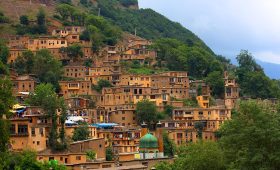Gilan Rural Heritage Museum: A Journey into the Heart of Gilan’s Culture
The Gilan Rural Heritage Museum (Muzeh-ye Mirath-e Rustayi-ye Gilan) is one of the most captivating attractions in Rasht, the capital of Gilan Province in northern Iran. This open-air museum offers visitors a unique opportunity to explore the rich cultural heritage of the Gilan region, showcasing the traditional architecture, lifestyle, customs, crafts, and daily life of rural communities.
Overview of the Museum
Situated on the outskirts of Rasht, the museum covers an extensive area and is home to 28 residential collections that reflect the diverse rural life across Gilan’s various districts. The museum is designed to recreate the architecture, living spaces, and environments typical of the rural communities from different parts of the province, offering a vivid snapshot of life in Gilan before modernization.
Opened in 2007, the museum is not just a place to view artifacts but also an interactive experience where visitors can learn about the history, culture, and traditions of the Caspian region. The museum provides a rich narrative about the local people’s connection with the land, their sustainable ways of living, and the unique blend of Caucasian, Mazandarani, and Gilaki influences that have shaped the province.
Architecture and Collections
The museum’s collections are spread across several sections that represent the different aspects of rural life. The 28 residential units are constructed using traditional materials like wood, mud, and stone, and are designed to mimic the local dwellings from Gilan’s villages. Some of the key architectural features include:
- Traditional Gilan Houses: These homes, often made of wood and clay, are designed to blend harmoniously with the natural surroundings, keeping cool in the summer and warm in the winter. The architecture is characterized by steep, gabled roofs and large open spaces that allowed for a comfortable and communal way of living.
- Traditional Kitchens: Visitors can explore the kitchens that feature clay stoves, cooking utensils, and traditional equipment used for food preservation and daily meals. The kitchens are often decorated with local handicrafts and woven fabrics.
- Gardens and Courtyards: The museum also features gardens and courtyards typical of rural homes in Gilan. These areas are used to grow local plants and vegetables, which contribute to the sustainable lifestyles of the people in the region.
Cultural Displays and Artifacts
In addition to the residential structures, the museum also exhibits various aspects of Gilan’s rural culture, including:
- Traditional Clothing: The museum displays a variety of folk costumes worn by both men and women in rural Gilan. The colorful fabrics and intricate embroidery showcase the artistic skills of the people and their strong connection to nature and local traditions.
- Craftsmanship: Gilan is known for its rich tradition of handicrafts, and the museum showcases several examples of carpets, pottery, weaving, and woodworking. Visitors can see how these items were crafted and how they played a role in the daily lives of the people.
- Local Food and Cuisine: One of the most fascinating aspects of the museum is its exploration of local food culture. Traditional dishes such as Mirza Ghasemi, Kabab Tabei, and Bademjan are highlighted, with demonstrations of how these meals were prepared using locally sourced ingredients and traditional methods.
- Tools and Utensils: The museum also displays a wide variety of traditional agricultural tools, farming equipment, and fishing gear, which were once essential to the rural economy of Gilan. These tools were used for farming, animal husbandry, fishing, and other rural activities.
Activities and Experiences
Visitors to the Gilan Rural Heritage Museum can engage in various activities that deepen their understanding of the province’s culture:
- Workshops and Demonstrations: The museum regularly holds workshops on traditional crafts such as weaving, pottery making, and cooking. These hands-on activities allow visitors to learn from skilled artisans and try their hand at these age-old crafts.
- Cultural Events and Festivals: The museum hosts numerous cultural events, including traditional music performances, folk dance exhibitions, and local food festivals, giving visitors a chance to experience the living culture of Gilan up close.
- Nature Walks: Since the museum is set in a picturesque location surrounded by lush greenery, visitors can also enjoy walks through the surrounding forests and fields, taking in the natural beauty of the Caspian Hyrcanian forests.
Educational Value
The Gilan Rural Heritage Museum is not only an important cultural destination but also an educational resource. It plays a significant role in preserving the traditional knowledge, skills, and lifestyle of Gilan’s rural communities, which are at risk of being forgotten in the face of urbanization and globalization. The museum serves as a hub for research and educational programs, where scholars and students can study the anthropology, history, and architecture of the region.
The Gilan Rural Heritage Museum is a must-visit destination for anyone interested in experiencing the traditional lifestyle of one of Iran’s most culturally rich provinces. It provides a comprehensive, immersive experience into the history, culture, and heritage of rural Gilan, offering visitors a chance to connect with the past while enjoying the beautiful natural surroundings. Whether you are interested in architecture, traditional crafts, food culture, or simply want to experience the rural life of Gilan, this museum offers something for everyone.

